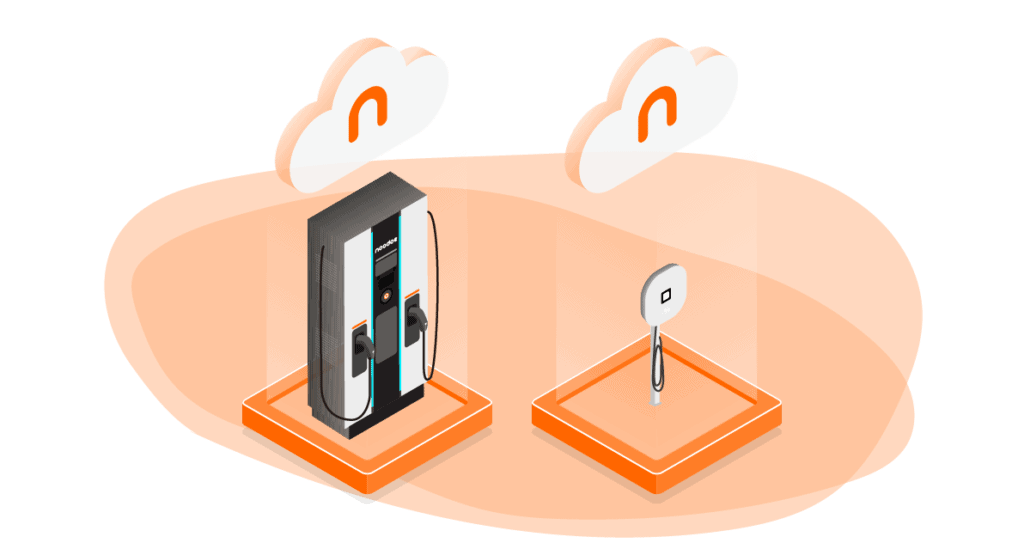Contact Info
2600 Technology Drive, Suite 100
Plano, Texas, 75074
United States
2600 Technology Drive, Suite 100
Plano, Texas, 75074
United States

Last Updated: March 8th, 2023 | Infrastructure
Installation of home chargers is a relatively easy thing. That’s because smart homeowners are tracking their EV-specific power usage with internet-connected chargers. The biggest decisions are often about where to place the chargers (inside or outside?) and what the power setup for the residence looks like. Once that’s decided; wire it up, make sure everything’s working, and you’re done. Easy. But not terribly efficient. Install internet connected EV chargers, however, and it’s a whole new ballgame!
Technically speaking, they’re not really that different. While the most basic EV chargers aren’t much more than a cable, installed home chargers are true electrical appliances. They need a proper installer to make sure they’re wired correctly.
However, smart EV chargers require an internet connection. That connection can be made in a few ways, and they have their benefits and drawbacks. An installer needs to know the differences and be able to make a value judgment for each site visited
Wi-Fi connections are convenient. Each charger can hook up to a local router to process payments and connect to Noodoe EV OS. However, hosts need to be careful about the Wi-Fi connection chosen for the chargers. As anyone who has watched streaming videos knows, Wi-Fi can be laggy. While that’s merely an irritation when it slows down your show, it’s much worse when it takes your chargers offline. Also, a consumer router will freeze after a few months and require a reset. Instead, hosting sites need high-quality, commercial-grade routers for the stable operation of charging stations. Commercial-grade routers offer years of continuous operation under harsh conditions. Additionally, they can auto-reboot should they stop working. This ensures dependable, automated service.
Some newer smart EV chargers have a slot for a SIM card now. SIM cards tend to be more reliable than Wi-Fi connections and are easy to install. Just as you would with a cell phone, find the appropriate slot inside your charging station and insert the SIM card. Each SIM card requires its own internet connection account through a service provider, so make sure you’ve got that covered before installation.
The methods described above are all for connecting chargers directly to the internet. However, from an installation standpoint, some projects may require a different approach. Noodoe chargers can also be connected through an on-site router or gateway, which connects to the internet through a SIM card connection. This setup allows for a strong connection from the units to the router or gateway while the data transmission is handled through the internet service provider. This approach can be used when units are located too far away from the main source of internet for either Wi-Fi or ethernet cables to be good options. This mixed-mode connection method allows installers to set up a site easily, even when the units are installed far from an IT room.
Being able to offer everything a customer needs is important when pitching a new project. While it might not be too much of a hassle to source internet-connected EV charging hardware and software separately, having high-quality options for both makes an installer that much more attractive to a site owner looking for choices. This is why Noodoe offers both quality AC and DC charging stations, as well as our best-in-class, cloud-based operating system: Noodoe EV OS.
Noodoe EV OS really is a game-changer for site owners. It supports owners and operators who know nothing about EV charging and helps them feel comfortable in the system. It’s efficient and user-friendly, and Noodoe offers excellent training for all new customers who need to learn the program. Additionally, it lightens customers’ workload by automating all financial transactions and seamlessly analyzing and recovering stations that need it. There’s no need for extra support personnel on staff when Noodoe EV OS has your back in the middle of the night!
For those looking to get a little more out of their operating system, Noodoe EV OS has a wealth of robust features. All connected EV chargers can charge by time or power used, can set peak hour pricing, and offers a range of analytics features to keep businesses sharp.connected
Transitioning from offering basic home chargers to connected smart chargers is easy. Installation is quick, and most installers already know everything they need to know to make the change. The only thing stopping them from doing it is knowing how simple it can be. To learn more about making the shift, reach out to Noodoe. We’d love to help!
| Cookie | Duration | Description |
|---|---|---|
| cookielawinfo-checkbox-analytics | 11 months | This cookie is set by GDPR Cookie Consent plugin. The cookie is used to store the user consent for the cookies in the category "Analytics". |
| cookielawinfo-checkbox-functional | 11 months | The cookie is set by GDPR cookie consent to record the user consent for the cookies in the category "Functional". |
| cookielawinfo-checkbox-necessary | 11 months | This cookie is set by GDPR Cookie Consent plugin. The cookies is used to store the user consent for the cookies in the category "Necessary". |
| cookielawinfo-checkbox-others | 11 months | This cookie is set by GDPR Cookie Consent plugin. The cookie is used to store the user consent for the cookies in the category "Other. |
| cookielawinfo-checkbox-performance | 11 months | This cookie is set by GDPR Cookie Consent plugin. The cookie is used to store the user consent for the cookies in the category "Performance". |
| viewed_cookie_policy | 11 months | The cookie is set by the GDPR Cookie Consent plugin and is used to store whether or not user has consented to the use of cookies. It does not store any personal data. |
